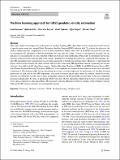Machine learning approach for GNSS geodetic velocity estimation
Author(s)
Özarpacı, Seda; Kılıç, Batuhan; Bayrak, Onur C.; Taşkıran, Murat; Doğan, Uğur; Floyd, Michael; ... Show more Show less
Download10291_2023_Article_1607.pdf (8.377Mb)
Publisher with Creative Commons License
Publisher with Creative Commons License
Creative Commons Attribution
Terms of use
Metadata
Show full item recordAbstract
This study aimed to investigate the performance of machine learning (ML) algorithms in determining horizontal velocity at specific points using the current Global Navigation Satellite System (GNSS) velocity field. To achieve this objective, the analysis utilized the most comprehensive velocity field available for Turkey, where 70% of the GNSS velocities was allocated for training the ML algorithms, while the remaining 30% was used for testing. Contrary to the previous research, the significance of considering the tectonic structure within the study area was emphasized at this point. To determine the tectonic structure of the horizontal velocity field in the region, a preliminary clustering procedure was conducted. Subsequently, distinct ML algorithms were trained using velocity fields associated with different tectonic plates. Moreover, to investigate the impact of the tectonic domain, the entire velocity field was also tested using ML algorithms without considering the tectonic structure. Four different ML algorithms, namely, Gradient Boosting Machines (GBM), LightGBM, Random Forest (RF), and eXtreme Gradient Boosting Machines (XGBoost), were employed to estimate the horizontal velocities (east and north components). The findings imply that incorporating the tectonic structure improved the performance of machine learning predictions, as indicated by the GBM algorithm's decreased root-mean-square error values. In addition, when the tectonic structure was taken into account, the accuracy assessment values for the RF and XGBoost algorithms in the east component decreased significantly. In terms of predicting GNSS velocities, the RF algorithm exhibited the lowest root-mean-square error values compared to other algorithms. The horizontal velocity differences between averages of the reference velocity field and the RF velocity estimates are maximum 0.4 mm/yr.
Date issued
2024-01-25Department
Massachusetts Institute of Technology. Department of Earth, Atmospheric, and Planetary SciencesPublisher
Springer Berlin Heidelberg
Citation
GPS Solutions. 2024 Jan 25;28(2):65
Version: Final published version